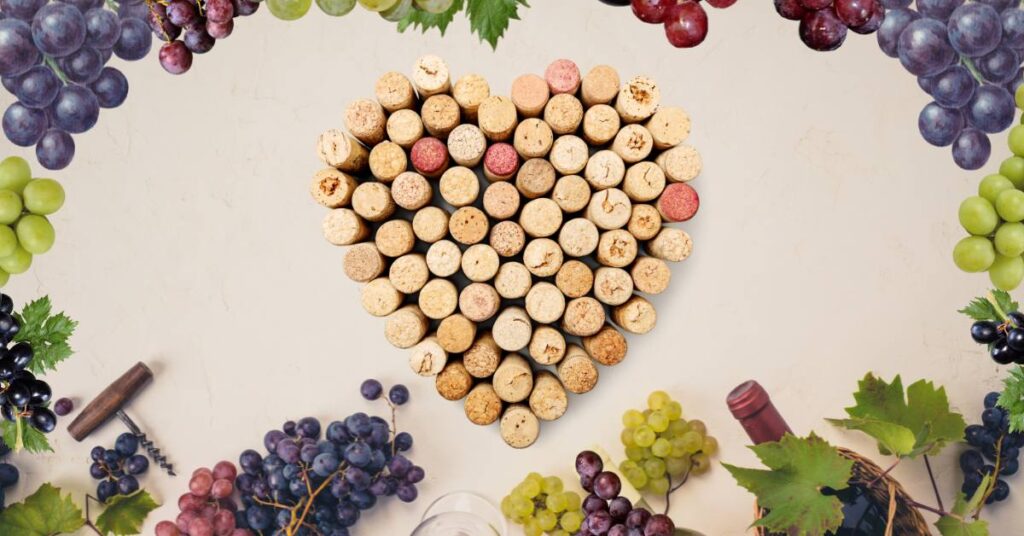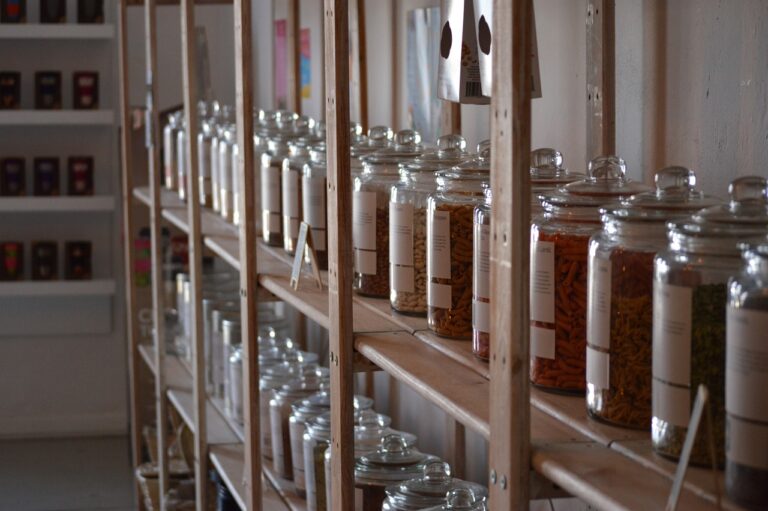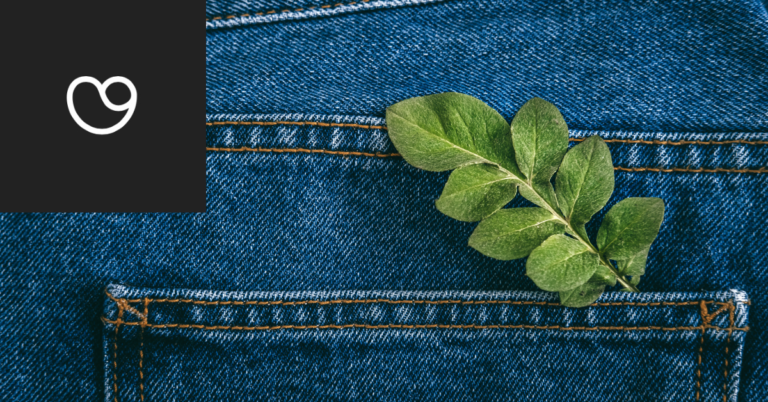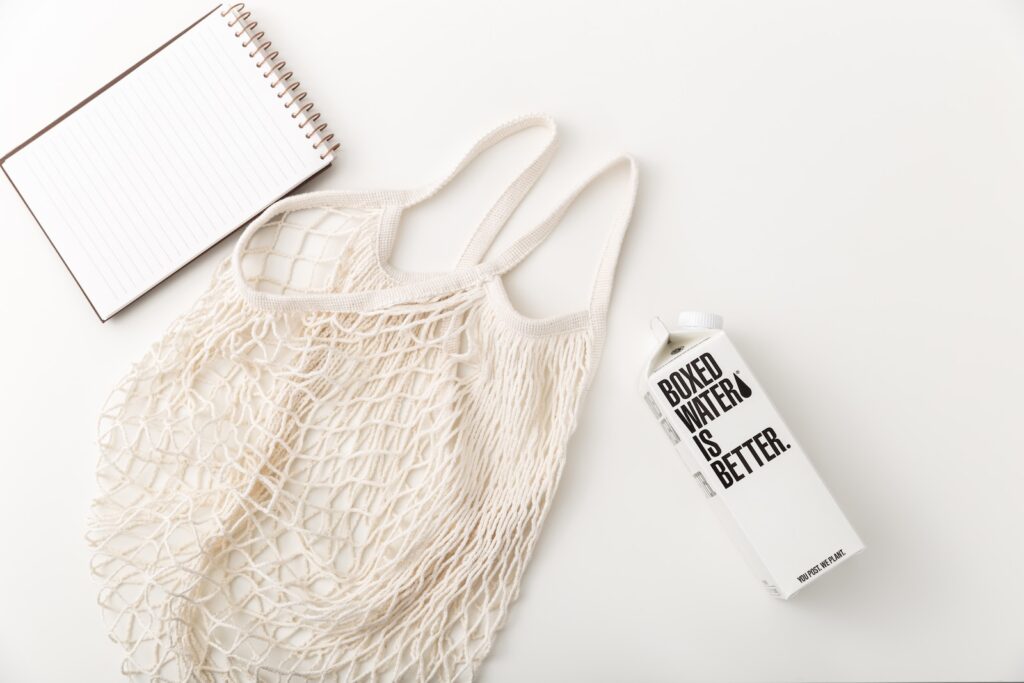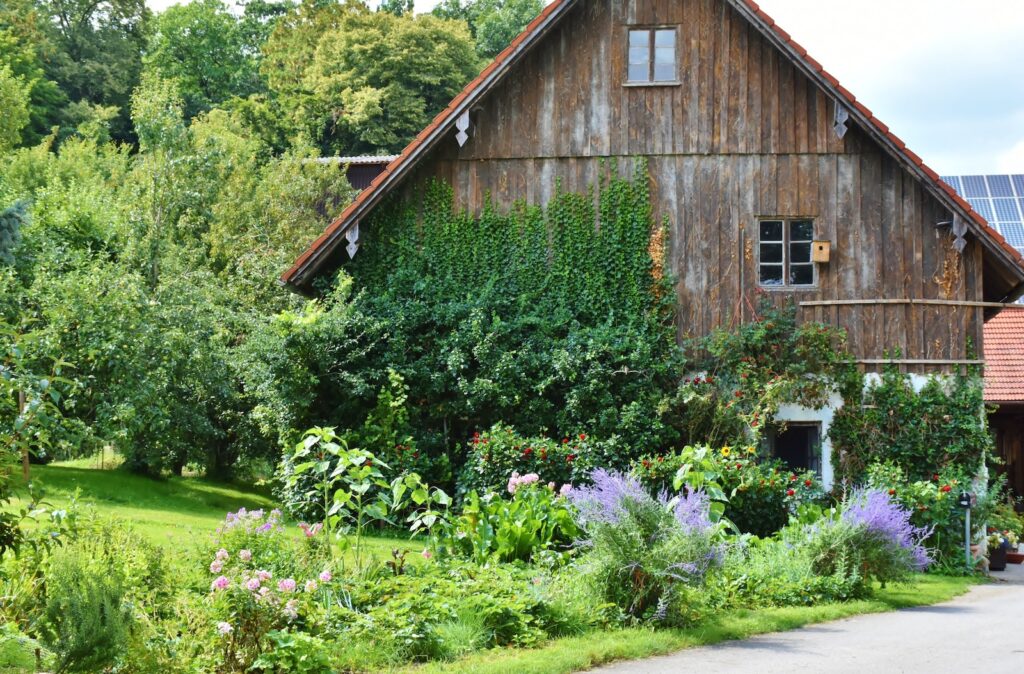Ah, the satisfaction of that final twist and pop when you open a new bottle of wine! But after the toasts are made, and the last drops savored, you’re left with a decision that’s not just about red or white, but green—can you compost or recycle the cork?
Attention, Wine Lovers!
If you’re like me, you adore a good glass of wine—the way it swirls in the glass, its bouquet, the rich or crisp flavors. But have you ever paused before tossing out the cork, pondering its fate? You’re not alone. It’s a valid question, considering the millions of bottles uncorked daily around the globe.
Problem, Uncorked!
The cork in your wine bottles might come from the bark of the cork oak tree—a natural wonder that’s both renewable and biodegradable. Then there are the synthetic pretenders—corks that mimic the look but not the eco-friendly qualities. Each has a different disposal path with its own impact on our planet.
Promise of Sustainability
But here’s the good news: Whether they’re popping from bottles of vintage Port or weeknight Merlot, those corks can continue their story in eco-friendly ways. Composting natural corks can enrich our soil, while recycling can give them new life in products like cork floors or bulletin boards. We’ll uncork the ins and outs of both options, so by the end of this blog post, you’ll not only be a wine connoisseur but a cork conservationist, too!
So grab a glass of your favorite vino—and let’s dive into the world of wine corks and their afterlife.
Understanding Wine Corks: From Tree to Bottle Top
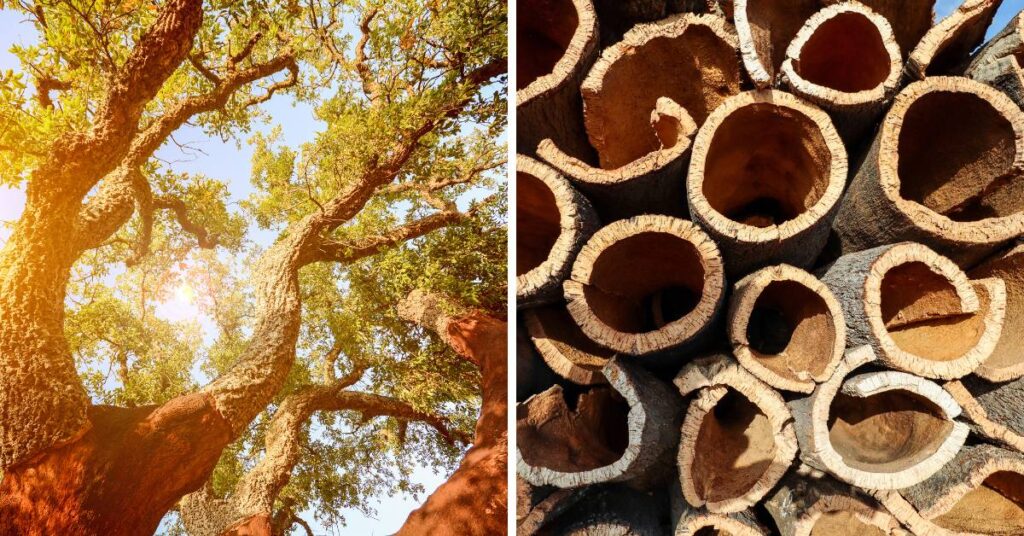

Not all corks are created equal. Let’s break it down:
Natural Corks
- Real Cork: The Original Eco-Warrior: Natural wine corks are the OGs of the cork world. They’re harvested from the bark of cork oak trees, meaning no cork trees are harmed in making your wine stoppers. Cork oak trees aren’t harvested until they are 25 year old adult trees. After that, the cork can be removed from the tree every nine years. It’s a 100% natural, renewable, and biodegradable material, making cork as earth-friendly as it is functional.
- Why It’s a Natural Wonder: The cork’s honeycomb structure makes it an excellent insulator and impermeable to liquids. This is why it’s been the top choice (pun intended) for wine preservation for centuries.
Synthetic Corks
- Plastic Corks: The Modern Twist: Enter the synthetic corks—these are the ones you’ll find in various colors, made from synthetic materials like plastic. They’re designed to look and function like natural cork.
- Synthetic Smarts: They’re less likely to crumble or vary in quality, giving winemakers and wine lovers a consistent experience. But, as with most things plastic, there’s an environmental cost to consider.
Composting Wine Corks: Nature’s Recycling Program
Composting Basics
Composting is a fantastic way to return nutrients to the earth, and it can be even more rewarding when you incorporate everyday items from around the house, like wine corks. It’s a simple act with a profound impact—reducing waste and enhancing your garden soil simultaneously.
Natural Corks in Composting
When it comes to composting, 100% natural corks are an excellent choice because they’re made from organic materials. Here’s how to do it:
1. Verify Cork Purity
Before adding corks to your compost bin, it’s essential to ensure they are made of pure natural cork and do not have any non-organic materials attached that cannot be composted. Some wine corks may have synthetic glues or plastic coatings that would contaminate your compost pile. Always check that you’re composting natural cork to avoid introducing unwanted materials to your organic waste.
2. Prep Your Corks
The best way to toss corks into the compost is by breaking them down first. Smaller pieces decompose more quickly, so consider shredding or chopping your corks before adding them to your compost bin.
3. The Decomposition Process
Remember that natural cork is dense and firm so it will take a long time to break down. Longer than most other organic matter. With time, those corks will break down and create rich compost for your garden.
Balancing Your Compost Pile
To ensure a healthy composting process:
Balance Your Browns and Greens
- Proper Mix: Corks are considered ‘brown’ compost material, high in carbon. They should be balanced with ‘green’ materials, high in nitrogen, like fruit and vegetable scraps, yard waste (grass clippings), or coffee grounds. A good mix of organic waste will keep your compost heap happy.
Including natural wine corks in your compost is a way to reduce waste and benefit your garden. It’s a small step towards a more sustainable lifestyle, aligning your love for wine with a commitment to the environment. Now, let’s look at recycling—another route for your corks that can’t be composted.
Recycling: Giving Old Corks New Life
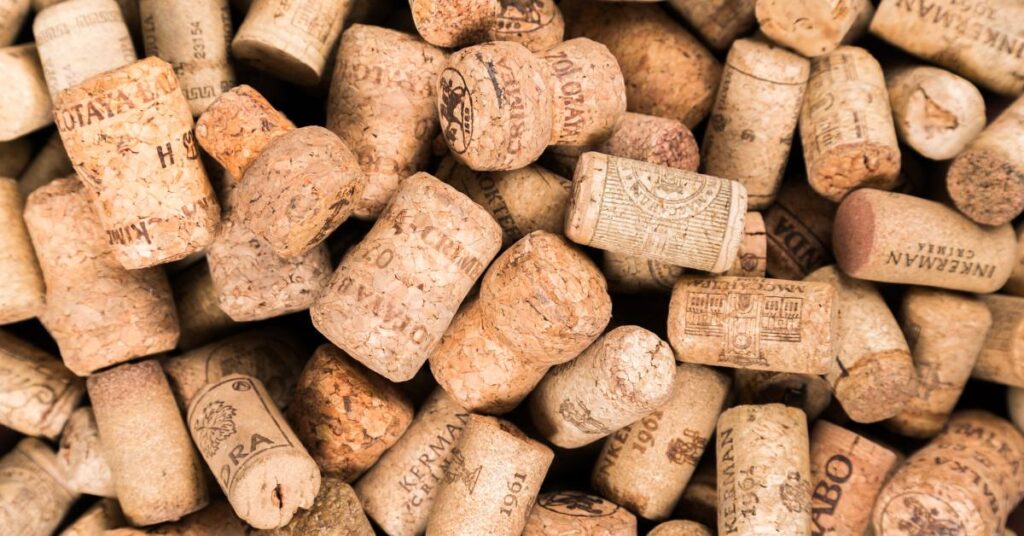

When Composting Isn’t an Option
Not everyone has the space or the means to compost at home, but that doesn’t mean your old wine corks have to end up in the landfill. Recycling can be an excellent alternative, allowing materials to be repurposed and reused in new and innovative ways.
The Journey of Cork Recycling
Corks can be more than just a wine stopper; they can be transformed into various products. Here’s what happens when you opt to recycle:
1. Types of Recyclable Corks
- Natural Cork Recycling: Natural corks are biodegradable and renewable, and they can be ground down into shredded cork and turned into a multitude of other products, like cork tiles, insulation, sports equipment, and even fashion accessories.
- Synthetic Corks: Unfortunately, synthetic corks are not biodegradable, but that doesn’t mean they’re not recyclable. Some specialized programs accept these corks to convert them into automotive gaskets, construction materials, and more.
2. How to Recycle Corks
- Drop-off Locations: Check for local wine shops or a recycling center that accepts natural and/or synthetic cork donations. There are also mail-in programs where you can send your corks to be recycled.
- Recork: Recork has drop box locations across the USA to drop off your natural corks. To find a location near you click here. You can also ship saved corks over 15 lbs directly to them. To find out how click here.
- Terracycle: Terracycle accepts synthetic corks for recycling via mail. However, it’s expensive to use their service. It’s better suited for green businesses than individuals. To find out how click here.
- Cork Forest Conservation Alliance (CFCA): The CFCA organization also works to recycle natural cork and invests in preserving and protecting cork forests and their ecosystems.
Recycling vs. Composting Corks
When deciding whether to compost wine corks or recycle them, consider the following:
1. Type of Cork: Composting is a viable option if it’s 100% natural cork. For synthetic wine corks, recycling is the way to go.
2. Environmental Impact: Both recycling and composting reduce the environmental impact in different ways. Composting returns nutrients to the soil, whereas recycling turns the material into a new product, potentially reducing the demand for virgin materials.
3. Local Facilities: Accessibility can be a deciding factor. If you have a local recycling program for corks, it’s a great way to ensure your corks get a second life.
4. Supporting Sustainability: By recycling corks, you also support industries that opt for sustainable practices, such as using renewable materials.
Final Thoughts on Recycling
Recycling your wine corks can be a responsible choice for the environment and a way to contribute to the circular economy. It’s about making informed decisions and taking small, actionable steps towards a more sustainable future.
Creative Reuses for Wine Corks
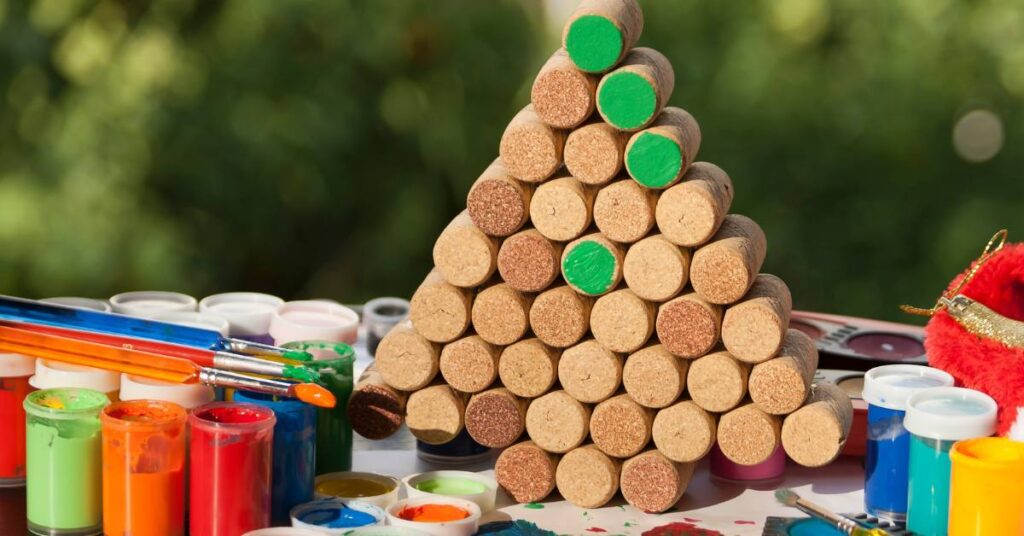

Beyond Recycling: Corks as a Craft Material
While composting and recycling are both eco-friendly options for disposing of wine corks, crafting with corks repurposes what would otherwise be waste and taps into the joy of DIY projects.
Here are a few fun things you can do with old corks:
Home Décor and Functional Art
- Cork Bulletin Boards: With a bit of glue and a backing board, corks can be transformed into stylish and functional bulletin boards that bring a touch of winery chic to your home office or kitchen.
- Cork Trivets and Coasters: Slicing corks into disks or piecing them together whole creates heat-resistant trivets and coasters, perfect for protecting your surfaces with a flair.
- Cork Pin Cushions: Glue a few corks together and use them as a pin cushion while sewing.
Gardening Applications
- Plant Markers: Write the names of herbs or vegetables on the corks and attach them to skewers to create charming plant markers for your garden.
- Mulching Material: Chopped corks can be used as cork mulch in potted plants, helping to retain moisture in the soil.
Arts and Crafts
- Cork Stamps: Carve the ends of corks into stamps for an afternoon of crafting with the kids or to add a personal touch to your stationery.
- Decorative Wreaths and Ornaments: Corks can be assembled into decorative shapes and designs, creating unique holiday wreaths, ornaments or decorations for a rustic touch to your décor.
Fashion and Accessories
- Cork Jewelry: Thin slices or small pieces of cork can be incorporated into earrings, necklaces, and bracelets.
- Keychains and Charms: Corks are lightweight and can be made into keychains and charms.
By repurposing your old wine corks, you’re not only diverting waste from landfills but also unleashing your creativity, potentially saving money on home goods, and maybe even starting a conversation about sustainability.
Conclusion: Best Practices for Your Wine Corks
If you’re a home composting enthusiast and prefer to see your waste turn into nourishment for your garden, composting your natural corks is a fantastic option. Remember to chop them into smaller pieces for quicker decomposition.
For those without the space or desire to compost, recycling both natural material and synthetic corks is a viable and responsible choice. Look for local drop-off locations or mail-in programs dedicated to cork recycling.
Unleash your inner artist by repurposing corks into practical items or beautiful crafts. Not only will you save money, but you’ll also have unique, handcrafted items that tell a story.
Wine corks can enrich our gardens, take on new forms, and even spark a conversation about conservation over a bottle of your favorite wine. It’s these small, everyday decisions that, when collected, can have a profound impact on our planet’s health. So, the next time you uncork a new bottle, remember that the life of that little cork doesn’t have to end there. Whether through composting, recycling, or crafting, its journey can continue in a way that benefits us all. Cheers to that!🍷✨
